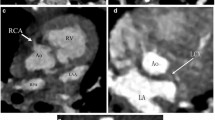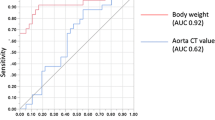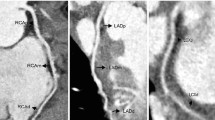Abstract
The objective of this study was to assess factors affecting image quality of 320-row computed tomography angiography (CTA) of coronary arteries in children with congenital heart disease (CHD). We retrospectively reviewed 28 children up to 3 years of age with CHD who underwent prospective electrocardiography (ECG)-gated 320-row CTA with iterative reconstruction. We assessed image quality of proximal coronary artery segments using a five-point scale. Age, body weight, average heart rate, and heart rate variability were recorded and compared between two groups: patients with good diagnostic image quality in all four coronary artery segments and patients with at least one coronary artery segment with nondiagnostic image quality. Altogether, 96 of 112 segments (85.7 %) had diagnostic-quality images. Patients with nondiagnostic segments were significantly younger (10.0 ± 11.6 months) and had lower body weight (5.9 ± 2.9 kg) (each p < 0.05) than patients with diagnostic image quality of all four segments (20.6 ± 13.8 months and 8.4 ± 2.5 kg, respectively; each p < 0.05). Differences in heart rate and heart rate variability between the two imaging groups were not significant. Receiver operating characteristic analyses for predicting patients with nondiagnostic image quality revealed an optimal body weight cutoff of ≤5.6 kg and an optimal age cutoff of ≤12.5 months. Prospective ECG-gated 320-row CTA with iterative reconstruction provided feasible image quality of coronary arteries in children with CHD. Younger age and lower body weight were factors that led to poorer image quality of coronary arteries.


Similar content being viewed by others
References
Al-Mousily F, Shifrin RY, Fricker FJ, Feranec N, Quinn NS, Chandran A (2011) Use of 320-detector computed tomographic angiography for infants and young children with congenital heart disease. Pediatr Cardiol 32:426–432
Ben Saad M, Rohnean A, Sigal-Cinqualbre A, Adler G, Paul JF (2009) Evaluation of image quality and radiation dose of thoracic and coronary dual-source CT in 110 infants with congenital heart disease. Pediatr Radiol 39:668–676
Defrance T, Dubois E, Gebow D, Ramirez A, Wolf F, Feuchtner GM (2010) Helical prospective ECG-gating in cardiac computed tomography: radiation dose and image quality. Int J Cardiovasc Imaging 26:99–107
Goo HW, Yang DH (2010) Coronary artery visibility in free-breathing young children with congenital heart disease on cardiac 64-slice CT: dual-source ECG-triggered sequential scan vs. single-source non-ECG-synchronized spiral scan. Pediatr Radiol 40:1670–1680
Goo H, Park I, Ko J, Kim Y, Seo D (2005) Visibility of the origin and proximal course of coronary arteries on non-ECG-gated heart CT in patients with congenital heart disease. Pediatr Radiol 35:792–798
Goo HW, Seo D-M, Yun T-J et al (2009) Coronary artery anomalies and clinically important anatomy in patients with congenital heart disease: multislice CT findings. Pediatr Radiol 39:265–273
Han BK, Grant KLR, Garberich R, Sedlmair M, Lindberg J, Lesser JR (2012) Assessment of an iterative reconstruction algorithm (SAFIRE) on image quality in pediatric cardiac CT datasets. J Cardiovasc Comput Tomogr 6:200–204
Herzog C, Mulvihill DM, Nguyen SA et al (2008) Pediatric cardiovascular CT angiography: radiation dose reduction using automatic anatomic tube current modulation. AJR Am J Roentgenol 190:1232–1240
Jadhav SP, Golriz F, Atweh LA, Zhang W, Krishnamurthy R (2015) CT angiography of neonates and infants: comparison of radiation dose and image quality of target mode prospectively ECG-gated 320-MDCT and ungated helical 64-MDCT. AJR Am J Roentgenol 204:184–191
Landis JR, Koch GG (1977) The measurement of observer agreement for categorical data. Biometrics 33:159–174
Legendre A, Losay J, Touchot-Kone A, Serraf A, Belli E, Piot JD (2003) Coronary events after arterial switch operation for transposition of the great arteries. Circulation 108:186–190
Lim J, Park E-A, Lee W, Shim H, Chung JW (2015) Image quality and radiation reduction of 320-row area detector CT coronary angiography with optimal tube voltage selection and an automatic exposure control system: comparison with body mass index-adapted protocol. Int J Cardiovasc Imaging. doi:10.1007/s10554-015-0594-1
Pache G, Grohmann J, Bulla S et al (2011) Prospective electrocardiography-triggered CT angiography of the great thoracic vessels in infants and toddlers with congenital heart disease: feasibility and image quality. Eur J Radiol 80:440–445
Pache G, Grohmann J, Bulla S et al (2011) Prospective electrocardiography-triggered CT angiography of the great thoracic vessels in infants and toddlers with congenital heart disease: feasibility and image quality. Eur J Radiol 80:440–445
Paul J-F, Rohnean A, Elfassy E, Sigal-Cinqualbre A (2011) Radiation dose for thoracic and coronary step-and-shoot CT using a 128-slice dual-source machine in infants and small children with congenital heart disease. Pediatr Radiol 41:244–249
Sorantin E, Riccabona M, Stücklschweiger G, Guss H, Fotter R (2013) Experience with volumetric (320 rows) pediatric CT. Eur J Radiol 82:1091–1097
Sun G, Li M, Jiang X-S et al (2012) 320-detector row CT coronary angiography: effects of heart rate and heart rate variability on image quality, diagnostic accuracy and radiation exposure. Br J Radiol 85:388–394
Thomas KE, Wang B (2008) Age-specific effective doses for pediatric MSCT examinations at a large children’s hospital using DLP conversion coefficients: a simple estimation method. Pediatr Radiol 38:645–656
Tsai I-C, Lee T, Chen M, Fu Y, Jan S (2007) Visualization of neonatal coronary arteries on multidetector row CT: ECG-gated versus non-ECG-gated technique. Pediatr Radiol 37:818–825
Vitiello R, McCrindle BW, Nykanen D et al (1998) Complications associated with pediatric cardiac catheterization. J Am Coll Cardiol 32:1433–1440
Willemink MJ, Leiner T, de Jong PA et al (2013) Iterative reconstruction techniques for computed tomography part 2: initial results in dose reduction and image quality. Eur Radiol 23:1632–1642
Williams MC, Weir NW, Mirsadraee S et al (2013) Iterative reconstruction and individualized automatic tube current selection reduce radiation dose while maintaining image quality in 320-multidetector computed tomography coronary angiography. Clin Radiol 68:570–577
Young C, Taylor A, Owens C (2011) Paediatric cardiac computed tomography: a review of imaging techniques and radiation dose consideration. Eur Radiol 21:518–529
Yu F-F, Lu B, Gao Y et al (2013) Congenital anomalies of coronary arteries in complex congenital heart disease: diagnosis and analysis with dual-source CT. J Cardiovasc Comput Tomogr 7:383–390
Zhang T, Wang W, Luo Z et al (2012) Initial experience on the application of 320-row CT angiography with low-dose prospective ECG-triggered in children with congenital heart disease. Int J Cardiovasc Imaging 28:1787–1797
Acknowledgments
The authors thank Mr. Taguchi Hiroshi (Toshiba Medical Systems Corporation) for his technical support.
Author information
Authors and Affiliations
Corresponding author
Ethics declarations
Conflict of interest
Okayama University Medical School has a grant from Toshiba Medical Systems. The authors have no other conflicts of interest.
Ethical approval
All procedures performed in studies involving human participants were in accordance with the ethical standards of the institutional and/or national research committee and with the 1964 Declaration of Helsinki and its later amendments or comparable ethical standards. For this type of study, formal consent is not required.
Rights and permissions
About this article
Cite this article
Tada, A., Sato, S., Kanie, Y. et al. Image Quality of Coronary Computed Tomography Angiography with 320-Row Area Detector Computed Tomography in Children with Congenital Heart Disease. Pediatr Cardiol 37, 497–503 (2016). https://doi.org/10.1007/s00246-015-1305-3
Received:
Accepted:
Published:
Issue Date:
DOI: https://doi.org/10.1007/s00246-015-1305-3




